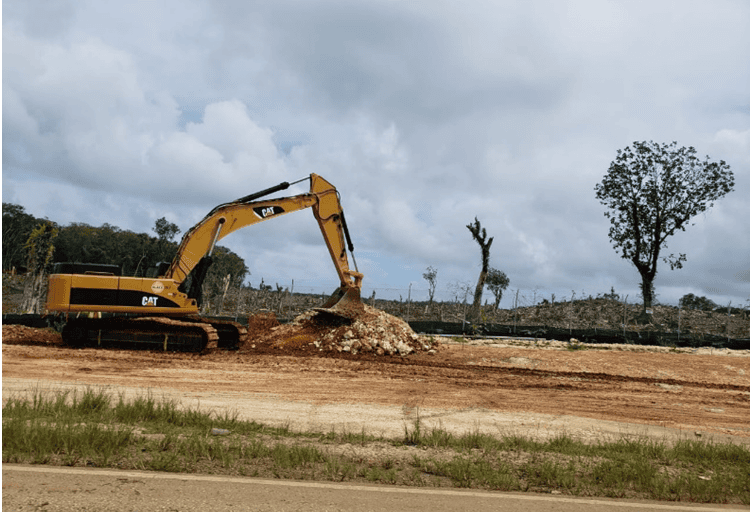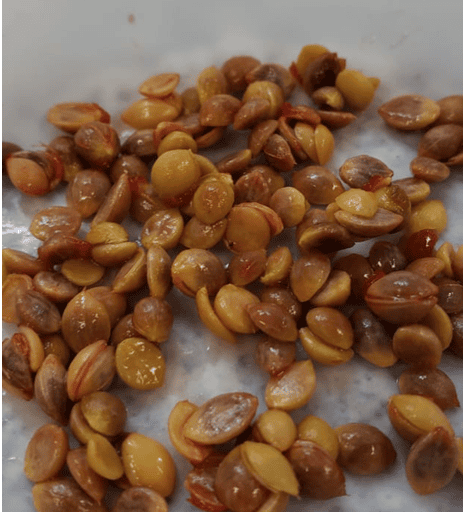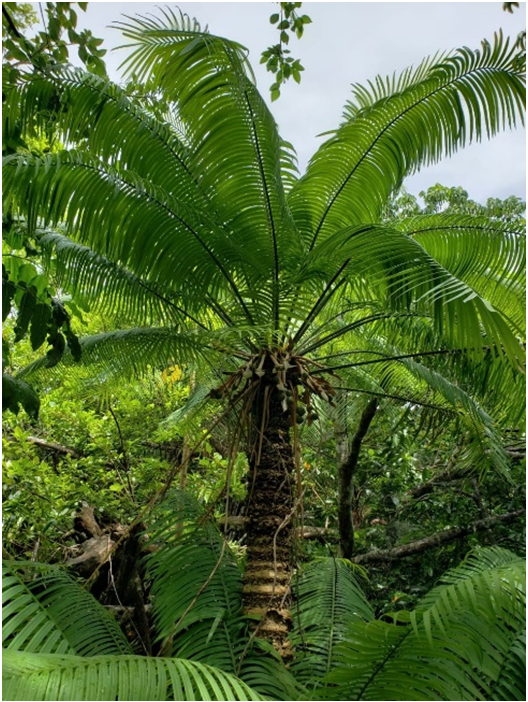- The U.S. Marine Corps is building a base on Guam that will destroy 400 hectares (1,000 acres) of limestone forest, habitat for numerous endangered species.
- As mitigation, the military is funding forest “enhancement” to remove invasive species from fenced zones and restore seed dispersal by native birds.
- The fence’s success depends on maintenance into perpetuity, but biologists on Guam question how long funding will really last.
Ritidian, a cliff-top refuge on the island of Guam, is one of the last places in the Pacific where you can find the mossy pillars and plunging crevices of a limestone forest. It is one of the only places you can still hear the wingbeats of an endangered Mariana fruit bat and the very last place on the island to brush against the feathery leaves of Guam’s single mature hayun lågu tree. But Ritidian is also the site of a proposed U.S. Marines firing range, part of an $87 billion construction project known as the Guam Build-Up.
Over the next five years, 5,000 Marines and their families are scheduled to relocate from Okinawa, Japan, to the new base, which will include housing and firing ranges. The project is slated to bulldoze 400 hectares (1,000 acres) of limestone forest, which the military reports as 8 percent of the remaining limestone forest left on Guam.
Alternative sites ignored
Sienna Hiebert, a Navy-contracted botanist on Guam, says the ecological impact of the construction will be far greater than the 8 percent of forest directly lost. The condemned forest comprises two large, continuous parcels of “pristine” limestone forest, according to Hiebert, while the remaining forest elsewhere is “so patchy.”
The U.S. Fish and Wildlife Service (USFWS) concurs. It describes the condemned land as primary limestone forest with greater biodiversity and more carbon sequestration than degraded forest elsewhere on Guam.
“The primary limestone forest on [Andersen Air Force Base] is considered some of the best native limestone forest left on Guam to serve as habitat for listed [threatened and endangered] species,” the agency wrote. “The removal and degradation of habitat includes some of the best remaining primary forest on Guam.”
The agency warned that “the majority of remaining limestone forests on Guam” are located on military land, putting them at risk for future development.
Hiebert says she believes the military could have picked a site requiring far less destruction. “There is plenty of land that could have been used. Half of the deforestation [will be] for housing, and there are plenty of sites that have old housing on them,” she says.
She says the military should have considered building on the southern half of the island, where grazing, wildfires and World War II bombing have already converted the landscape to a grassy savanna.

Joni Quenga Kerr, an associate professor of science at Guam Community College, also says she fears the development will undo years of conservation work. As mitigation for a previous project, the military spent $1.1 million to fence off a portion of Ritidian.
“The fence was meant to keep out invasive ungulates (wild pigs and deer) and serve as critical habitat for endangered species,” Kerr wrote in an e-mail. “The million-dollar fence will be torn down to build the firing range.”
In its Biological Opinion, the USFWS strongly encouraged an alternative location. “The [Department of the Navy] should replace the proposed project footprint for the [Live-Fire Training Range Complex] with an alternative that does not clear the primary limestone forest at Ritidian Point, does not demolish the ungulate fence at Ritidian Point, and does not put a [Surface Danger Zone] over the [Guam National Wildlife Refuge],” the agency wrote. The military did not heed this advice.

Limestone wonder
Kerr has spent her career studying this ecosystem. “Limestone forests were once submerged tropical reefs made by corals and other organisms that produced calcium carbonate skeletons,” she says. “Upon walking into a pristine limestone forest, one that has never been cleared or leveled for farming or development, one has to walk carefully to avoid tripping and falling onto uneven, sharp-edged karst.”
The limestone forest threatened by construction is habitat for dozens of endemic and endangered species of bats, birds, butterflies, geckos, skinks, tree snails, cycads, trees, ferns and orchids. The list includes the critically endangered Mariana crow (Corvus kubaryi), fragile tree snail (Samoana fragilis) and Guam tree snail (Partula radiolata).
But no species will more affected than the hayun lågu (Serianthes nelsonii), the tallest tree in the Marianas Islands and one of the most endangered species in the world. Its flowers, sprays of magenta threads dipped in gold, bloom from only one tree on Guam and 30 or so others on the neighboring island of Rota. The proposed firing range at Ritidian will envelop the last mature hayun lågu on Guam. The military has promised the tree will be left standing surrounded by a 30-meter (100-foot) buffer and, beyond that, according to plans, a practice area for machine gunners. The USFWS has nurtured and transplanted seedlings from the adult tree throughout Ritidian. These seedlings “constitute much of the entire Guam genetic lineage of S. nelsonii,” the agency wrote, “and all are within the proposed project’s footprint.”
Guam has been a strategic U.S. territory since its liberation from Japanese occupation in 1944. But Kerr says Guam “really belongs” to its indigenous people, the CHamoru, who have lived here for 4,000 years.
“I am a CHamoru and I care deeply about our limestone forests,” Kerr says. “Tearing down the trees and flattening the karst in a pristine area, just to have a place for marines to practice, is not worth it. Once destroyed, the character, essence, and beauty of a limestone forest are gone forever.”

A fence for a forest
To mitigate the construction damage, the Marine Corps has committed to “enhance” 400 hectares of limestone forest elsewhere on Guam.
Al Borja, environmental director of the Marine Corps Activity Guam Public Works Department, says this enhancement is a chance to tackle invasive species.
The brown tree snake (Boiga irregularis) arrived on Guam in the late 1940s, probably on the landing gear of a U.S. military plane. The snake, which eats eggs, has nearly eradicated the island’s bird life. Of Guam’s 13 native forest bird species, three have gone entirely extinct. Two exist only in captivity. Five persist on neighboring islands. And only three species remain on Guam, and these are barely hanging on. Two male Mariana crows persist in the north, Mariana swiftlets (Aerodramus bartschi) nest in a few caves, and one small population of Micronesian starlings (Aplonis opaca guami) lives among the military housing on Andersen Air Force Base.
Without birds, the spider population has spiked to 40 times higher than in adjacent islands, and seed dispersal of native fruit trees has declined by up to 92 percent. Guam is the only place in the world where all fruit-eating wildlife species are functionally extinct. As a result, the majority of seedlings sprout directly beneath their parent trees, and many tree species are producing no viable offspring.
Meanwhile, invasive Philippine deer (Rusa marianna) and feral pigs (Sus scrofa) nibble most of the saplings that do manage to sprout. The limestone forest has become a silent canopy of aging trees, largely devoid of the next generation.

The military’s mitigation plan hinges on excluding invasive species from pockets of forest and planting native saplings, grown from seeds salvaged from the construction zone.
At a cost of $40 million, biologists are fencing off a patchwork of “enhancement” sites within Guam’s remaining forest. An ungulate-exclusion fence will encircle a total of 400 hectares, while sharpshooters will pick off any deer and pigs trapped inside.
The military also plans to erect a snake-proof fence around 65 hectares (160 acres) of forest, with an additional 121 hectares (300 acres) if the test site succeeds. Biologists plan to helicopter-drop dead mice stuffed with acetaminophen, the active ingredient in Tylenol, to attract and poison any brown tree snakes inside the fence.
In the future, these patches of snake-free forest could serve as habitat for native forest birds. The U.S. Fish and Wildlife Service hopes to reintroduce the locally extinct Guam rail (Gallirallus owstoni) and Guam kingfisher (Todiramphus cinnamominus), while Iowa State University biologist Haldre Rogers is propping up the Micronesian starling. If these and other fruit-eaters return to Guam, they could potentially disperse tree seeds across the island and restore the limestone forest’s ability to regenerate itself.
The U.S. Marine Corps advertises this acre-for-acre trade — one acre enhanced for every acre developed — as a positive for Guam’s ecosystem.
“Taken as a whole, the implementation of natural resource conservation measures and other restoration offsets that are part of the Marine Corps relocation would have a net-positive benefit to all protected species habitats affected by development,” Borja told the Pacific Daily News.


Kerr, on the other hand, sees the trade-off as a bad deal for Guam.
She says that although invasive species have altered the island’s ecology, “development is the primary reason that limestone forests are one of the most endangered forest types in the world.”
Part of the mitigation involves salvaging hundreds of plants from the construction zone, including three kinds of epiphytic orchid and the only two known host species for the endangered Mariana eight-spot butterfly (Hypolimnas octocula marianensis). But Guam’s biologists find flaw with the plan’s execution.
The host plants will be moved “from the area most populated by the endangered eight spot butterfly, to an area where few if any butterflies are found,” according to Kerr. And the orchids have been relocated to a site above Haputo Beach, where the military recently announced plans to expand a small-arms firing range, said Hiebert.
Many species extirpated on Guam survive on its smaller neighbors, the Northern Mariana Islands, which remain free of brown tree snakes. Here, an endangered, ground-dwelling bird called the Micronesian megapode (Megapodius laperouse) still incubates its eggs with volcanic heat. The critically endangered Mariana skink (Emoia slevini) still congregates in social groups. The endangered Mariana fruit dove (Ptilinopus roseicapilla) still disperses seeds, the endangered Mariana wandering butterfly (Vagrans egistina), listed by the Endangered Species Act, still emerges from black-spiked caterpillars, and the endangered Pacific sheath-tailed bat (Emballonura semicaudata) still roosts colonially in forest caves.
However, the military now intends to use two of these islands, Tinian and Pågan, for training. The military will acquire the northern two-thirds of Tinian and the entirety of Pågan for war simulation exercises, including high-impact bombardment, helicopter and sea landings, and firing of mortars, grenades, rockets and bombs.
The proposal to turn these two islands into mock war zones prompted a lawsuit by indigenous and conservation groups, who argued that the training would destroy native forests, coral reefs, and CHamoru lands. The groups accused the military of obscuring its cumulative impact on the Mariana Islands ecosystem.
“There isn’t any comprehensive document that shows all of these areas where [the military has] proposed to destroy the forest and put in all these training areas, housing, and firing ranges. I think they’ve done this on purpose to make them seem like small things, [but] they’re all clearly part of the same relocation of the Marines,” Hiebert says.


Hiebert plays a key role in the forest enhancement project. As a military-contracted botanist, she is responsible for salvaging seeds from the condemned forest, germinating them in a shade-cloth nursery, and planting hundreds of thousands of native saplings within the fenced zones.
Hiebert would prefer to restore all of Guam, without sacrificing any forest, but she doesn’t think anyone will pay for conservation on that scale.
“Most people that are on the remediation side think that this [trade-off] is Guam’s only hope in saving the native forest. This is the only way that funding could possibly get procured,” Hiebert says. “I wish it were different, but for some reason, to save a forest you have to destroy a nicer one.”

Hiebert describes maintaining the fences as “a forever goal.” One gap in the fence would compromise its function.
“If the snakes do come back in, they will eventually wipe out the bird population which, again, affects [seed] dispersal,” she says. “And if the ungulates come back in, then they eat all the seedlings again.”
According to Borja, the military is “committed to the long-term maintenance of these [forest enhancement] sites, subject to Congressional authorization.”
Yet Hiebert says she expects funding to last for only 30 years. She worries about the long-term maintenance of the fence.
“Who’s actually going to fund it after 30 years?” she says. “Is all of this work going to be for naught, and … in 30 years, all the fence is going to decay, all the snakes are going to come back in, all the deer are going to eat all the seedlings, and the birds are all going to die?”
Hiebert views her work as a gamble. The “ultimate question” is whether the trade-off — 400 hectares of limestone forest lost in exchange for 400 hectares enhanced — will turn out to be a good deal for Guam’s ecosystem as a whole.
“If it works, it was worth it,” Hiebert says. “But if it doesn’t, then it was a huge catastrophe.”
Banner image: Limestone forest within the construction footprint of a proposed U.S. Marine Corps base and firing-range complex on the Pacific island of Guam. Image courtesy of Sienna Hiebert.
